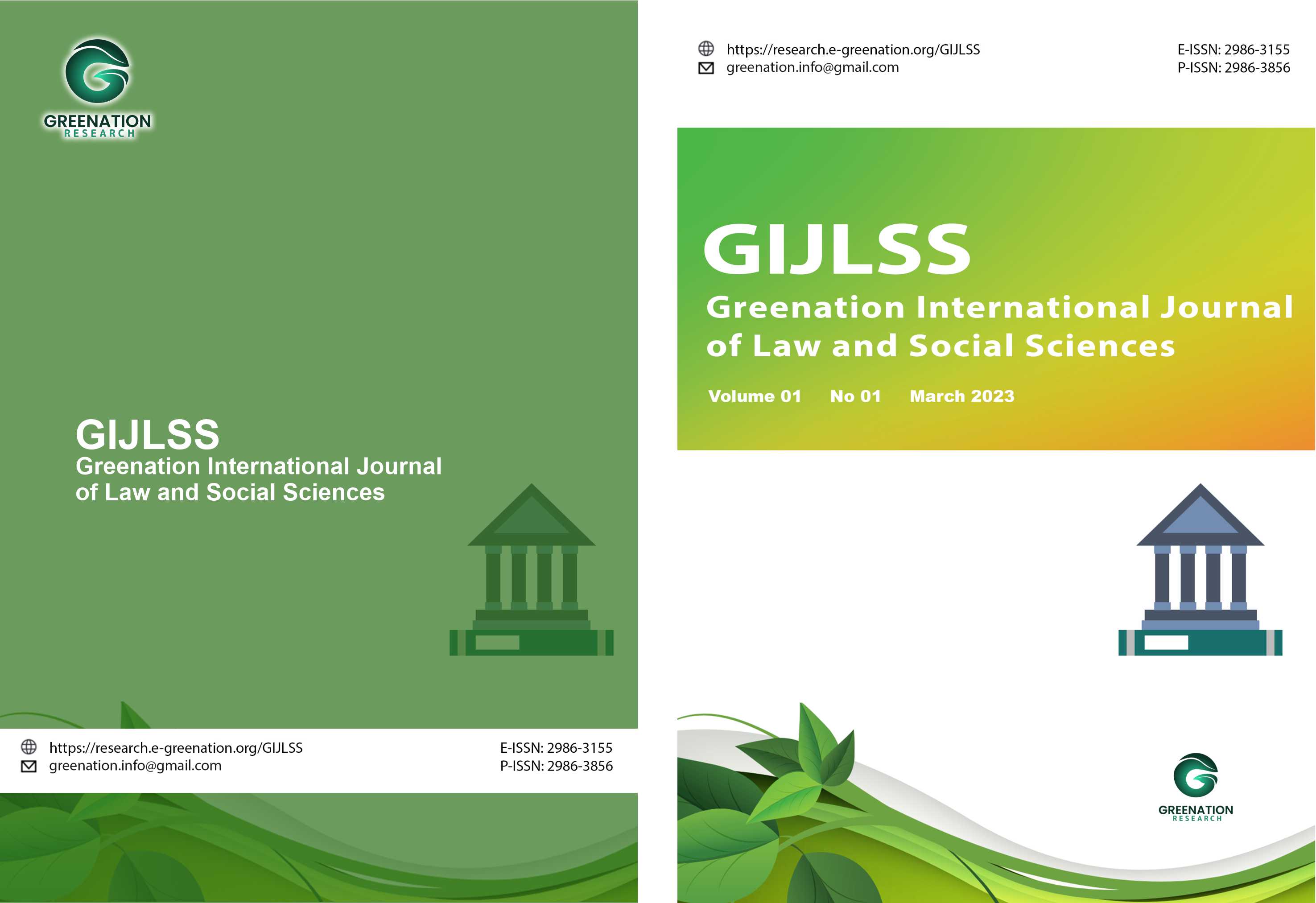The Concept of Peaceful Fines on The Implementation of Restorative Justice in The Development of Criminal Law in Indonesia
DOI:
https://doi.org/10.38035/gijlss.v3i2.489Keywords:
Peace Fines, Corruption, Restorative Justice, Police DepartmentAbstract
There is a conceptual error in the existence of peaceful fines when viewed from the implementation of peaceful fines itself, especially when applied to minor corruption crimes, which basically can be attached to the police institution, so that the fast track of criminal justice can be realised. Therefore, the purpose of the research conducted by researchers in this study is to find the concept of peaceful fines for the incorporation of restorative justice into Indonesia's evolving criminal code. Descriptive analysis is the research specification, and a normative juridical approach is the research methodology. Primary, secondary, and tertiary legal resources are the sources of the data. This research found that there is a social contract attached to state responsibility for the losses suffered by victims. This state responsibility is substantially and fundamentally attached to the state by attaching environmental losses and community losses in addition to state financial losses. Thus, the concept of punishment for corruption offences will be erroneous when only the state finances that are harmed are the focus. This also leads to amicable fines being the focus of punishment for corruption offences which will also be erroneous. The implementation of the concept of restorative justice in the form of peaceful fines places the Police as the implementer considering the ‘vanguard’ of law enforcement in Indonesia. On the other hand, the police also function as a conduit of information or a copy to the prosecutor's office and judges in court, the final result of which is an amicable fine set by the court.
References
Adinda Shafiyah, Elisatris Gultom. (2024). Hukum Sebagai Pengatur Dan Pelindung Kehidupan Sosial Individu Dan Masyarakat. Gudang Jurnal Multidisiplin Ilmu, 2 (10), 466-471, Doi: https://doi.org/10.59435/gjmi.v2i11.484
Ali Marwan HSB. (2016). Mengkritisi Pemberlakuan Teori Fiksi Hukum. Jurnal Penelitian Hukum De Jure, 16(3). 251 - 264
Andri Kristanto. (2022). Kajian Peraturan Jaksa Agung Nomor 15 Tahun 2020 Tentang Penghentian Penuntutan Berdasarkan Keadilan Restoratif, Jurnal 7(1), 180-193. DOI: 10.20885/jlr.vol7.iss1.art14.
Dani Aswara, “Wacana Denda Damai bagi Koruptor, Komisi Kejaksaan: Harus Punya Landasan Hukum Kuat“, diakses melalui https://www.tempo.co/politik/wacana-denda-damai-bagi-koruptor-komisi-kejaksaan-harus-punya-landasan-hukum-kuat-1192321,
Dwi Atmoko, Amalia Syauket. (2022). Penegakan Hukum Terhadap Tindak Pidana Korupsi Ditinjau dari Perspektif Dampak Serta Upaya Pemberantasan. Binamulia Hukum, 11 (2), 177-191, DOI: 10.37893/jbh.v11i2.732
Eddy OS Hiariej. (2014). Prinsip-Prinsip Hukum Pidana, Cahaya Atma Pustaka, Yogyakarta.
G.P. Hoemagels. (2013). The Other Side of Criminology, Kluwer Deventer, Holland.
Hanaf Arifi, Ningrum Ambarsari. (2018). Penerapan Prinsip Restoratif Justice Dalam Sistem Peradilan Pidana di Indonesia, Al-Adl: Jurnal Hukum 10(2), 173-190. DOI: 10.31602/aladl.v10i2.1362.
Indra Gunawan. (2023). Penggunaan Denda Damai Dalam Tindak Pidana Ekonomi. The Prosecutor Law Review, 1(2), 68-86
Ismail Ali. (2023). Visum Et Repertum Sebagai Alat Bukti Dalam Tindak Pidana Penganiayaan, LEGAL: Journal of Law, 2(1), 43-55, DOI: https://jurnal.lamaddukelleng.ac.id/index.php/legal/article/view/48 hlm 43
Johny Ibrahim. (2008). Teori dan Metodologi Penelitian Hukum Normatif, Bayumedia, Surabaya.
Moeljatno. (2015). Asas-Asas HukumPidana, Rineka Cipta, Jakarta.
Niko Muhammad Insani. (2024). Paradigma Restorative Justice dalam Penegakan Hukum Pidana (Studi Kasus Pencurian 1 Unit Handphone di Provinsi Nusa Tenggara Barat Tahun 2023). Jurnal Ilmu Hukum Humaniora dan Politik, 4(6). 2403-2411, DOI: https://doi.org/10.38035/jihhp
Rabith Madah Khulaili Harsya, (2022), Penetapan Sanksi Pidana Dan Tindakan Sebagai Sistem Pemidanaan Di Indonesia, Yustisia Merdeka: Jurnal Imiah Hukum, 8(2), 57-63. DOI: https://doi.org/10.33319/yume.v8i2.182
Rolando Ritonga. (2023). Manifestasi Kewenangan Kejaksaan Dalam Penerapan Denda Damai Dalam Tindak Pidana Ekonomi Guna Mengubah Tatanan Sosial Masyaraka. The Prosecutor Law Review, 1(2), 21-34
Sigar P. Berutu, et al. (2024). Analisis Yuridis Putusan Nomor 152/Pid.C/2014/Pn.Rap Dikaitkan Dengan Perma Tentang Tindak Pidana Ringan Nomor 2 Tahun 2012. Jurnal Review Pendidikan dan Pengajaran, 7(2). 4691-4702
Soerjono Soekanto dan Sri Mamudji. (2003). Penelitian Hukum Normatif, PT. Raja Grafindo Persada, Jakarta
Soerjono Soekanto. (2010). Pengantar Penelitian Hukum, UII Press, Jakarta
Yulida Medistiara, “Jaksa Agung Ingin Korupsi di Bawah Rp 50 Juta Tak Dipidana, Ini Alasannya”, diakses melalui https://news.detik.com/berita/d-5973554/jaksa-agung-ingin-korupsi-di-bawah-rp-50-juta-tak-dipidana-ini-alasannya,
Zulkarnain Koto, Syafruddin, Tagor Hutapea. (2024). Kebijakan Polri Dalam Upaya Mengefektifkan Penerapan Konsep Hukum Pidana Baru Dalam Uu Ri Nomor 1 Tahun 2023 Tentang KUHP. Jurnal Ilmu Kepolisian, 18(1), 1-21, DOI: https://doi.org/10.35879/jik.v18i1.445.
Downloads
Published
How to Cite
Issue
Section
License
Copyright (c) 2025 Alwafi Setyana Mufid, Rachmat Sentika, Joko Setiono

This work is licensed under a Creative Commons Attribution 4.0 International License.
Copyright :
Authors who publish their manuscripts in this journal agree to the following conditions:
- Copyright in each article belongs to the author.
- The author acknowledges that the Greenation International Journal of Law and Social Sciences (GIJLSS) has the right to be the first to publish under a Creative Commons Attribution 4.0 International license (Attribution 4.0 International CC BY 4.0).
- Authors can submit articles separately, arrange the non-exclusive distribution of manuscripts that have been published in this journal to other versions (for example, sent to the author's institutional repository, publication in a book, etc.), by acknowledging that the manuscript has been published for the first time at GIJLSS.
























